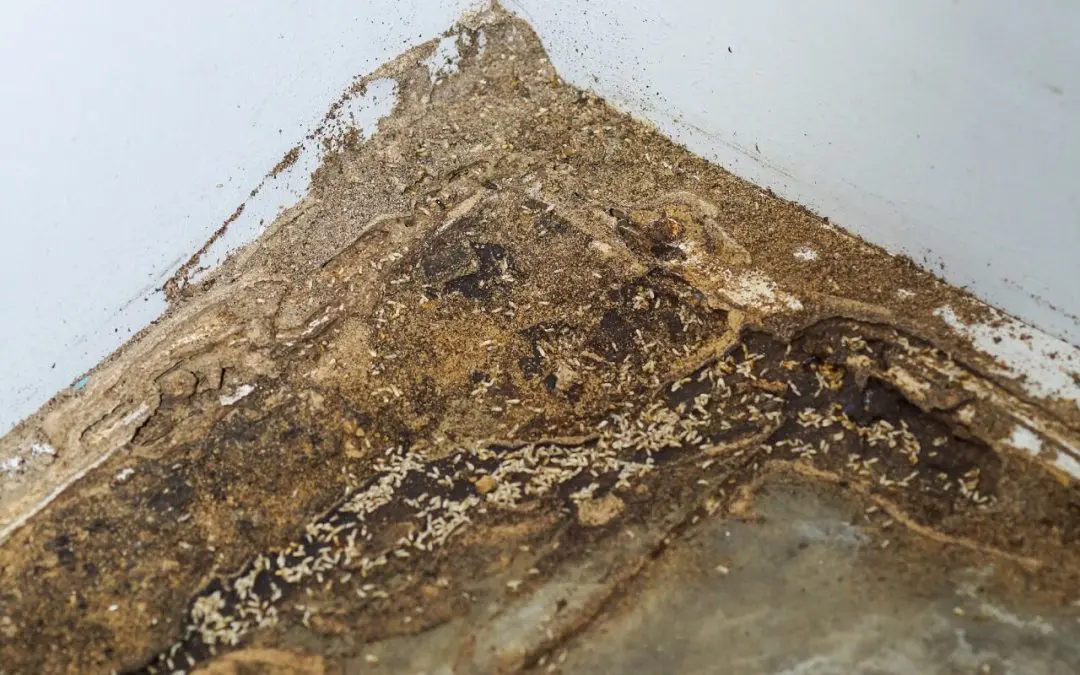Termites can chew through wood, flooring, and even wallpaper undetected, causing extensive and expensive damage to your home’s structure. Unlike a wasp or an ant, you might not see the pests themselves until an infestation is severe. That’s why every homeowner must know the subtle but undeniable signs of termites. Recognizing these warnings early is the best way to prevent expensive structural repairs.
The Most Visible Signs of Termites
Termite infestations often begin with a swarm. These swarms typically happen in the spring or after heavy rain. They may be briefly visible near a window, door, or light source. However, the swarm itself is often fleeting. What they leave behind is the most telling clue, discarded wings. After a brief flight, swarmers shed their wings. You may find small piles of translucent wings, which look like tiny fish scales, near windowsills, doors, or even spiderwebs inside your home. Finding these shed wings indicates that a termite colony is either inside or very close to your structure. If you see this, please don’t wait; it’s a critical warning sign of termites.
Mud Tubes and Frass: Physical Signs of Termites
Unlike carpenter ants, subterranean termites do not expose themselves to the open air. They need a moist, protected environment to travel between their underground colony and the wooden structure of your home. They build specialized transit routes called mud tubes. These mud tubes are constructed from soil, wood, and saliva, and look like thin, pencil-width tunnels running up foundation walls, support beams, or interior walls. If you find these tubes, carefully break a small section off. If termites immediately appear to repair the breach, the colony is active. If the tube is empty and brittle, the colony may be dormant, but its past presence still requires investigation.
Another key physical clue is frass, which is termite droppings. Drywood termites (found in warmer climates) do not build mud tubes; instead, they push their excrement out of the tunnels they create. This frass looks like tiny piles of sawdust or pepper-sized pellets and is often found on surfaces directly below where they are burrowing. The appearance of frass confirms an active drywood infestation.
Damaged Wood and Floor Sagging: Structural Signs of Termites
The most expensive damage caused by termites results from their continuous feeding on wood, which eventually compromises the structure of your home. You need to look beyond the surface for these signs of termites. When tapping or knocking on wood suspected of being infested, it may sound hollow or dull. Termites eat wood from the inside out, leaving a thin veneer or layer of paint on the surface. If you see wood that appears chipped or is easily damaged by a gentle poke from a screwdriver or pen, it may be riddled with termite galleries beneath.
Other structural indicators include sagging floors or ceilings. If your flooring feels soft, spongy, or unusually squeaky in localized spots, it could be a sign that the subfloor has been damaged by tunneling termites. Similarly, look for doors and windows that suddenly stick or are difficult to open. Termite activity and the moisture they introduce may cause wood framing to swell and warp, preventing normal operation.
The Importance of a Professional Termite Inspection
Identifying the subtle signs of termites requires expertise. Even if you spot a few wings or a small mud tube, you don’t know the extent of the infestation or if there are multiple colonies active on your property. This is why a professional termite inspection is non-negotiable for homeowner security. A certified inspector knows exactly where to look, in crawl spaces, utility entry points, foundation cracks, and other hidden areas that most homeowners never check. They use specialized tools to detect hidden activity and will identify the species of termite, which determines the appropriate treatment plan. A professional inspection provides a comprehensive risk assessment, confirming or ruling out the signs of termites and providing peace of mind. Investing in regular inspections is the single best preventive measure against the silent destroyer.
Frequently Asked Questions (FAQs)
How long does it take for termites to cause damage?
While a single termite works slowly, a mature colony contains hundreds of thousands of termites and can cause significant structural damage in as little as three years, and visible damage may appear much sooner.
Are termite mud tubes always active?
No. A mud tube could be a sign of a past infestation that has gone dormant. However, the only way to know for sure is to have it inspected.
How is termite damage different from water damage?
Water damage typically causes wood to swell, soften, and darken, often accompanied by mold or mildew. Termite damage creates distinct, hollow galleries or tunnels within the wood. If the wood sounds hollow and has tunnels but isn’t near a known leak, the signs of termites are likely present.
Should I call a professional immediately if I see wings?
Yes. Finding shed wings is one of the most conclusive signs of termites and indicates that a colony has successfully matured and is reproducing. You should have an inspection of the area.
HomeVantage Home Inspections provides termite inspection services to homebuyers and sellers in Northern New Jersey. Contact us to schedule an appointment.

